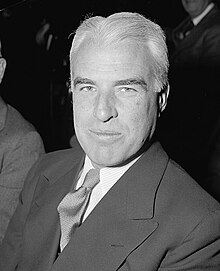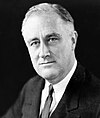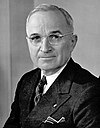Edward Stettinius Jr.
Edward Stettinius Jr. | |
|---|---|
 Stettinius in 1939 | |
| 1st United States Ambassador to the United Nations | |
| In office January 17, 1946 – June 3, 1946 | |
| President | Harry S. Truman |
| Preceded by | Position established |
| Succeeded by | Warren Austin |
| 48th United States Secretary of State | |
| In office December 1, 1944 – June 27, 1945 | |
| President | Franklin D. Roosevelt Harry S. Truman |
| Preceded by | Cordell Hull |
| Succeeded by | James F. Byrnes |
| 12th United States Under Secretary of State | |
| In office October 4, 1943 – November 30, 1944 | |
| President | Franklin D. Roosevelt |
| Preceded by | Sumner Welles |
| Succeeded by | Joseph Grew |
| Administrator of the Office of Lend-Lease Administration | |
| In office March 11, 1941 – September 25, 1943 | |
| President | Franklin D. Roosevelt |
| Preceded by | Position established |
| Succeeded by | Leo Crowley (Foreign Economic Administration) |
| Personal details | |
| Born | Edward Reilly Stettinius Jr. October 22, 1900 Chicago, Illinois, U.S. |
| Died | October 31, 1949 (aged 49) Greenwich, Connecticut, U.S. |
| Resting place | Locust Valley Cemetery |
| Political party | Democratic |
| Spouse | Virginia Gordon |
| Children | 3 |
| Parent | Edward R. Stettinius |
| Education | University of Virginia |
Edward Reilly Stettinius Jr. (October 22, 1900 – October 31, 1949) was an American businessman who served as United States Secretary of State under Presidents Franklin D. Roosevelt and Harry S. Truman from 1944 to 1945, and as U.S. Ambassador to the United Nations in 1946.
Early life and education
[edit]Stettinius was born in Chicago, Illinois, on October 22, 1900, the younger of two sons and third of four children of Edward R. Stettinius and Judith Carrington. His mother was a Virginian of colonial English ancestry. His father was of German descent and was a native of St. Louis, Missouri.[1]
The younger Stettinius grew up in a mansion on the family's estate on Staten Island and graduated from the Pomfret School in 1920, after which he attended the University of Virginia until 1924. He finished very few courses and never took a degree.[2] Instead he spent his time on charitable outreach to poor families. He became a member of the secret Seven Society.[3]
Career
[edit]In 1926, Stettinius began working at General Motors as a stock clerk, but his connections made for rapid advancement. He became assistant to John Lee Pratt, a friend of the family, and by 1931 he had become vice president of public and industrial relations. At General Motors, he worked to develop unemployment relief programs and came into contact with New York Governor Franklin Roosevelt.
In the 1930s, Stettinius's work in the private sector alternated with public service. He served on the Industrial Advisory Board of the National Recovery Administration (1933). In 1934 he returned to the private sector when he joined U.S. Steel, the nation's largest corporation; he eventually become chairman in 1938.[4]
He then returned to public service, serving on the National Defense Advisory Commission, as chairman of the War Resources Board (1939) and administrator of the Lend-Lease Program (1941).[5] He held the latter position until he became undersecretary of state in 1943. In January 1944, Macmillan published his book, Lend-Lease, Weapon for Victory.[6]
The poor health of Secretary of State Cordell Hull made Stettinius the chair of the 1944 Dumbarton Oaks Conference and, in December 1944, he succeeded Hull as Secretary of State.[7]
While Secretary of State, Stettinius composed in 1944 an airgram describing Bulgaro-Yugoslav efforts at establishing an independent "Macedonian" state (i.e., Vardarska) as "unjustified demagoguery representing no ethnic or political reality" (implying that the Macedonians are Greek), and "a possible cloak for aggressive intentions against Greece":[8]
The Department has noted with considerable apprehension increasing propaganda rumors and semi-official statements in favor of an “autonomous Macedonia”, emanating principally from Bulgaria, but also from Yugoslav Partisan and other sources, with the implication that Greek territory would be included in the projected state. This Government considers talk of “Macedonian nation”, “Macedonia Fatherland”, or “Macedonian national consciousness” to be unjustified demagoguery representing no ethnic or political reality, and sees in its present revival a possible cloak for aggressive intentions against Greece. The approved policy of this Government is to oppose any revival of the Macedonian issue as related to Greece. The Greek section of Macedonia is largely inhabited by Greeks, and the Greek people are almost unanimously opposed to the creation of a “Macedonian state.” Allegations of serious Greek participation in any such agitation can be assumed to be false. This Government would regard as responsible any Government or Group of Governments tolerating or encouraging menacing or aggressive acts of “Macedonian forces” against Greece. The Department would appreciate any information pertinent to this subject which may come to your attention.
Stettinius, U.S. State Department, Foreign Relations Vol. VII, Washington, D.C. Circular Airgram (868.014/26 Dec.1944).
Stettinius was a member of the US delegation to the February 1945 Yalta Conference.[9]
Truman thought Stettinius was too soft on communism, and had yielded too much to Moscow when he was Roosevelt's advisor at Yalta.[10][a] Truman had an old Senate friend in mind as a replacement, James F. Byrnes. Stettinius resigned as Secretary of State to accept the position of the first United States Ambassador to the United Nations. He chaired the United States delegation to the United Nations Conference on International Organization held in San Francisco from April 25 to June 26, 1945, which brought together delegates from 50 Allied nations to create the United Nations. Charles W. Yost, who had been Under Secretary of State Stettinius' assistant in the State Department, was named Stettinius' Executive Secretary at the United Nations Conference.
Stettinius resigned in June 1946, as he became critical of what he saw as Truman's refusal to use the UN as a tool to resolve tensions with the Soviet Union.[14][15] For three years after his return to private life, Stettinius served as rector of the University of Virginia. In 1947, Stettinius and friend William Tubman, the president of Liberia, helped form the Liberia Company (now International Registries), a partnership between the Liberian government and American financiers to provide funds for the development of the African nation.
Personal life
[edit]On May 15, 1926, Stettinius married Virginia Gordon Wallace, daughter of a prominent family of Richmond, Virginia. They had three children: Edward Reilly III and twins Wallace and Joseph.[7]
During his retirement, Stettinius lived at his Virginia estate, The Horseshoe, on the Rapidan River.[16] He died of a coronary thrombosis on October 31, 1949, at the home of a sister in Greenwich, Connecticut, at the age of 49, and was buried in the family plot in Locust Valley Cemetery, Locust Valley, New York.

Archive
[edit]Stettinius's voluminous archive of more than 1,000 boxes resides at the Albert and Shirley Small Special Collections Library at the University of Virginia.[17]
Notes
[edit]- ^ Ales was in Yalta, Moscow, Mexico City, and San Francisco when Stettinius and his Assistant Wilder Foote were. Ales was associated with GRU information such as tank production and steel production.[11][12][13] After Moscow Ales attended a function with Colonel General Fyodor Fedotovich Kuznetsov, who was the head of GRU on Soviet Army's General Staff from March 1943 to September 1947, and Colonel Mikhail Abramovich Milstein, who was a GRU officer active in the United States and Canada during the late 1930s, attended the Yalta conference and whose code name was “Mil’sky”.[11] While Ales was in Moscow, he was congratulated for his work for the Soviet Union.
References
[edit]- ^ Chernow, Ron (1990). The House of Morgan: An American Banking Dynasty and the Rise of Modern Finance. New York: Grove Press. pp. 188–189. ISBN 978-0-8021-3829-3.
- ^ "The Optimist". Time. November 7, 1949. Archived from the original on April 1, 2008. Retrieved August 14, 2008.
- ^ Johnson, Bill (February 15, 1965). "Seven Society's Secret Still Secret". Washington Post. pp. C8.
- ^ Herman, Arthur (2012). Freedom's Forge: How American Business Produced Victory in World War II. New York, NY: Random House. pp. 80, 87–90. ISBN 978-1-4000-6964-4.
- ^ Herman, Arthur (2012). Freedom's Forge: How American Business Produced Victory in World War II. New York, NY: Random House. pp. 70–1, 80, 87, 89, 125, 127, 150, 153, 155. ISBN 978-1-4000-6964-4.
- ^ Stettinius, Edward R. Lend-Lease, Weapon for Victory. New York: The Macmillan Company, 1944. OCLC 394271
- ^ a b "U.S. At War: Mr. Secretary Stettinius". Time. December 11, 1944. ISSN 0040-781X. Retrieved March 21, 2022.
- ^ Martēs, Nikolaos K.; Whitehouse (trans.), Deborah (2002). The Macedonians and their Contribution to Western Civilization. Athens: Diachronikes Ekdoseis. p. 32. ISBN 9789608172050.
- ^ Lafeber, Walter (1989). The American Age: United States Foreign Policy at Home and Abroad Since 1750. New York: W.W. Norton. pp. 417–418. ISBN 0-393-95611-3.
- ^ Hammersmith, Jack L. (1992). "In Defense of Yalta: Edward R. Stettinius's Roosevelt and the Russians". The Virginia Magazine of History and Biography. 100 (3): 429–454. ISSN 0042-6636. JSTOR 4249295.
- ^ a b Bird, Kai; Chervonnaya, Svetlana (June 1, 2007). "The Mystery of Ales (Expanded Version): The argument that Alger Hiss was a WWII-era Soviet asset is flawed. New evidence points to someone else". The American Scholar. Retrieved June 17, 2021.
- ^ Haynes, John Earl (June 7, 2007). "Ales: Hiss, Foote, Stettinius?". johnearlhaynes.org. Retrieved June 17, 2021.
- ^ Lowenthal, John (2000). "The Alger Hiss Story: A Search for the Truth". The Times Literary Supplement. Archived from the original on September 8, 2021. Retrieved September 9, 2021.
This is a reprint of "Venona and Alger Hiss" by John Lowenthal in Intelligence and National Security, Volume 15, Number 3 (Autumn 2000) [www.the-tls.co.uk/articles/private/venona-and-alger-hiss/]
- ^ Michael J. Devine and Nathan Giles. "Stettinius, Edward Reilly, Jr."
- ^ Truman, Harry. "Letter Accepting Resignation of Edward R. Stettinius as U.S. Representative to the United Nations". The American Presidency Project. Retrieved March 21, 2022.
- ^ "Thomas & Talbot | Make the Virginia hunt country your own". www.thomasandtalbot.com. Retrieved August 9, 2020.
- ^ "A Guide to the Papers of Edward R. Stettinius, Jr., 1924, 1949–1950 Stettinius, Edward R., Jr., Papers 2723-z". ead.lib.virginia.edu. Retrieved March 21, 2022.
Further reading
[edit]- Devine, Michael J. and Nathan Giles. "Stettinius, Edward Reilly, Jr."; American National Biography Online 2000; Access Date: Jun 06 2017
- "Edward Reilly Stettinius". Dictionary of American Biography, Supplement 4: 1946-1950. American Council of Learned Societies, 1974.
- Hopkins, Michael F. "President Harry Truman's Secretaries of State: Stettinius, Byrnes, Marshall and Acheson." Journal of Transatlantic Studies 6.3 (2008): 290–304.
- Johnson, Walter. "Edward R. Stettinius, Jr.," in An Uncertain Tradition: American Secretaries of State in the Twentieth Century, ed. Norman A. Grabner (1961).
- Walker, Richard L. "E. R. Stettinius, Jr.," in The American Secretaries of State and Their Diplomacy, vol. 14, (1965) online
Primary sources
[edit]- Edward Stettinius, Roosevelt and the Russians (New York, 1950) his memoirs of the Yalta Conference
- The Diaries of Edward R. Stettinius, Jr., 1943-1946, ed. Thomas M. Campbell and George C. Herring (New Viewpoints, 1975), ISBN 0531055701
External links
[edit] Media related to Edward Stettinius, Jr. at Wikimedia Commons
Media related to Edward Stettinius, Jr. at Wikimedia Commons- Time cover
- Edward Stettinius, Eleanor Roosevelt National Historic Site
- Office of the Historian - Biographies of the Secretaries of State: Edward Reilly Stettinius Jr. (1900–1949)
- 1900 births
- 1949 deaths
- 20th-century American politicians
- American Episcopalians
- American people of German descent
- Deaths from coronary thrombosis
- Franklin D. Roosevelt administration cabinet members
- General Motors executives
- National Recovery Administration
- People from Staten Island
- Permanent Representatives of the United States to the United Nations
- Politicians from Chicago
- Truman administration cabinet members
- United States secretaries of state
- United States Under Secretaries of State
- University of Virginia alumni
- World War II political leaders
- Pomfret School alumni
- Burials at Locust Valley Cemetery





